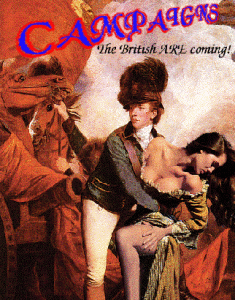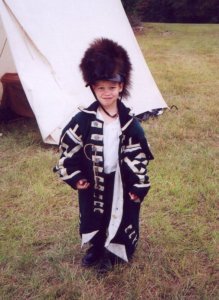In Camp Follower, I wrote one of the most controversial figures from the Revolutionary War, British Lt. Colonel Banastre Tarleton, into the novel as a secondary character. In contrast to creating and sustaining a fictional character, wrestling a reasonable Tarleton onto the page proved to be no easy task. For one thing, despite all the debate he generates, the real guy just isn’t polarized.
My first exposure to him came when I was a child, with Disney’s TV show, "The Swamp Fox." The Tarleton of this series was Walt Disney’s kiddie version. He came across as a boring, proper gentleman, almost forgettable. But his name lodged in my memory, became part of the mythology surrounding the Revolutionary War that American children learn in history class.
 Fast-forward to 1999, when I began earnest research on the Revolutionary War in preparation for writing Paper Woman. Tarleton and his exploits dominated history and folklore of the Southern theater. Just about everywhere I looked, he and the green-coated British Legionnaires colored the landscape. As folklore boogey monsters, these men slaughtered pregnant women, ate children, raped women, and disinterred corpses. In 2000, Hollywood via Roland Emmerich gave us "The Patriot," with Jason Isaacs oozing evil, wicked, mean, and nasty in his portrayal of Colonel Tavington, a thinly disguised version of the folklore Tarleton.
Fast-forward to 1999, when I began earnest research on the Revolutionary War in preparation for writing Paper Woman. Tarleton and his exploits dominated history and folklore of the Southern theater. Just about everywhere I looked, he and the green-coated British Legionnaires colored the landscape. As folklore boogey monsters, these men slaughtered pregnant women, ate children, raped women, and disinterred corpses. In 2000, Hollywood via Roland Emmerich gave us "The Patriot," with Jason Isaacs oozing evil, wicked, mean, and nasty in his portrayal of Colonel Tavington, a thinly disguised version of the folklore Tarleton.
Wow, an entire regiment of sociopaths on the big screen. Timely, what hey? Nothing like what good ole Uncle Walt gave us with “The Swamp Fox.” Excepting Norman Bates, sociopaths didn’t get much airtime pre-Hippy and pre-‘Nam. But TV viewers in the 21st century can invite “Dexter” into their homes once a week. Go figure.
As I’ve always been skeptical of the “truth” as told by Hollywood and folklore, I sought out reputable scholars and historians like Dr. Tony Scotti, Dr. Larry Babits, and John Robertson. There I learned about the Tarleton who was a resourceful regiment commander, professional soldier, compelling leader, and handsome ladies’ man — but not necessarily a brilliant military strategist. Yes, he had a substantial ego. Yes, he practiced Total War, like patriot counterparts such as Henry (“Light Horse Harry”) Lee. However he was no more ruthless than they. Were Tarleton living in modern times, he’d likely have been aimed at Twelve-Step programs for his issues with alcohol, spending, and gambling. Investigators today might quickly dismantle most atrocities attributed to Tarleton and the Legion due to faulty event sequences, questionable reliability of witnesses, and so forth. Tarleton seems to have been liked, trusted, and respected by Legion cavalrymen and infantrymen, which suggests that he led with his virtues, rather than his vices. Tarleton, a sociopath? Hmm, let’s just say that my fictitious Lt. Dunstan Fairfax makes a more convincing sociopath.
 To further muddy matters, some folks today don’t believe that Tarleton had an evil, wicked, mean, or nasty bone in his body. His fan club has a web site. There’s also a rock band named after him. Here’s a PhotoShopped version of the famous Reynolds portrait of Tarleton, emailed to me back in 2000 by a Tarleton fan. Hey, if you’re an author in the Romance Writers of America, grab this idea and run with it. Your audience is guaranteed.
To further muddy matters, some folks today don’t believe that Tarleton had an evil, wicked, mean, or nasty bone in his body. His fan club has a web site. There’s also a rock band named after him. Here’s a PhotoShopped version of the famous Reynolds portrait of Tarleton, emailed to me back in 2000 by a Tarleton fan. Hey, if you’re an author in the Romance Writers of America, grab this idea and run with it. Your audience is guaranteed.
.
 Plus the British Legion creates an impressive sight on the Revolutionary War reenactment battlefield. My sons’ first reenactment was Revolutionary War Field Days 2000, in Camden, South Carolina. Here’s my younger son, almost swallowed in the uniform of a legionnaire. Check out the little guy’s grin. Could it get much better than that? Shortly after, I hijacked Dr. Seuss to capture the wide-eyed wonder of a five-year-old boy who is surrounded by campfires, muskets, and bearskin hats:
Plus the British Legion creates an impressive sight on the Revolutionary War reenactment battlefield. My sons’ first reenactment was Revolutionary War Field Days 2000, in Camden, South Carolina. Here’s my younger son, almost swallowed in the uniform of a legionnaire. Check out the little guy’s grin. Could it get much better than that? Shortly after, I hijacked Dr. Seuss to capture the wide-eyed wonder of a five-year-old boy who is surrounded by campfires, muskets, and bearskin hats:
“Dr. Seuss Meets the British Legion”
(with apologies to Theodor S. Geisel)
Copyright 2000 by Suzanne Williams. All rights reserved.
Tarleton:
I am Ban. Ban I am.
Young recruit:
That Ban-I-am, that Ban-I-am,
I do not like that Ban-I-am!
Tarleton:
Do you like green men and Ban?
Young recruit:
I do not like them, Ban-I-am.
I do not like green men and Ban.
Tarleton:
You do not like us.
So you say.
Try us! Try us!
And you may.
Try us and you may, I say.
Waxhaws, Camden, Ninety Six.
We can move and we are quick.
Rebels fear the color green.
We are Charlie’s war machine.
Kill their chickens, pigs, and cow.
Ruin their lives. Yes, we know how.
Torch their crops and famine bring.
Gotta love mad George, our king.
Green horse thunder in the night.
Starving children all take flight.
(Spare the ladies, flirt and sigh.
In ten years you will know why.)
Rebels beg upon their knees.
Lop their arms off, if you please.
Sabers stained with purple gore.
Yes, we practice Total War.
Will you help us burn a house?
Next we will unearth a corpse.
Rebels homeless. Watch them flee.
Terror is such fun, you see!
Young recruit:
Say, I like that fluffy hat.
Those tall boots, just look at that!
Shiny spurs and jacket green.
You’re way-cool, you war machine.
Can I stay and learn some tricks?
Fire a musket when I’m six?
In the saddle I’m a man.
Thank you, thank you, Ban-I-am!
(Okay, I’ve never claimed to be a poet.)
Did I mention that we still have a lot of trouble distinguishing folklore about
Tarleton from fact? This summer, a columnist from a small-town Georgia paper contacted me about substantiating his belief that historians slight the South when it comes to the Revolutionary War. By the time I got back to him, he’d already published his original article, but he was still eager to publish a letter from me to the editor. Well, I took one look at his article and cringed. He hadn’t done the proper research and had mistaken as fact several incidents of folklore about Tarleton. So I wrote a letter to the editor that supported the columnist while gently correcting his mistakes. They never published my letter. I’m guessing that they read it, realized the magnitude of their error, and decided to drop the topic.
All of the above have fed into and fueled my desire to portray a balanced, human portrait of Banastre Tarleton. I may have been nuts to take on a historical figure laden with so much baggage, but I have to say that the research and writing were loads of fun. Not that my depiction of Tarleton is Absolute Truth, but the more we research with open minds, the more we can approximate the accuracy of what was once a real person.
**********
Did you like what you read? Learn about downloads, discounts, and special offers from Relevant History authors and Suzanne Adair. Subscribe to Suzanne’s free newsletter.

An enjoyable and balanced look at Ban Tarleton.
History is mainly told by the winners and much of the urban legend that has come down to us about Ban was told by his enemies and hardly objective.
I happen to love him dearly, but I’m ever mindful of his very real faults. He’s quite fascinating, but full of human foibles and failings, as well as virtues.
Loved the Ban I Am adaptation — I’m still chuckling as I type this.
I had a long conversation with John Robertson several years ago when I took a friend up to visit Cowpens, after he gave us the grand tour. He knows his stuff and was quite interesting to talk to.
I have this absurd picture in my mind of Ban and George Hanger being transported to our time and left in Las Vegas. I figure they’d either paint the town red or end up getting bumped off by the mob or both. Heh.
Thanks, Tracy. John Robertson is a dangerous guy. He recently went skydiving to celebrate his 75th birthday. And many years ago, after he’d given me his excellent tour of the Cowpens battlefield, I went back to my motel room for the night, caught the tail end of a TV report on biker gangs, and dreamed that night of Ban and Dan riding choppers.
Tarleton and Hanger doing Vegas? Ohhh my gawd.